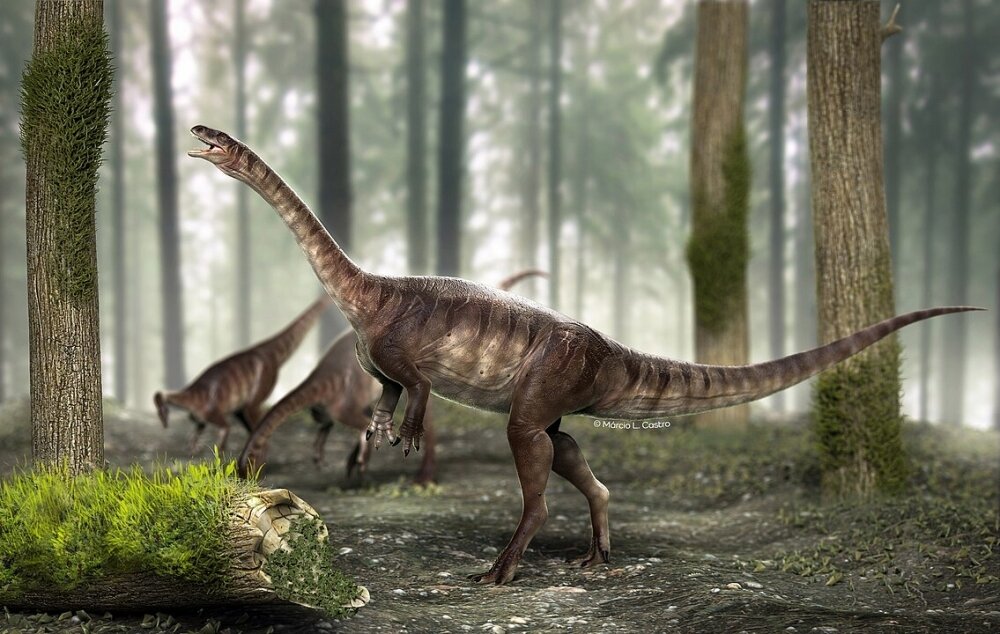The recent discovery of a remarkable dinosaur fossil in Rio Grande do Sul state, South Brazil, has provided new insights into the evolution of long-necked dinosaurs. Researchers have found bone cavities called air sacs in the ancestors of these dinosaurs, dating back approximately 225 million years. These air sacs played a crucial role in enabling dinosaurs to grow larger and adapt to their harsh environment. Contrary to previous beliefs, the study shows that the evolution of air sacs was not a linear process. This groundbreaking research sheds light on the extraordinary diversity and growth of dinosaurs during their reign on Earth.
Macrocollum itaquii, an ancient dinosaur buried 225 million years ago in Agudo, Rio Grande do Sul state, South Brazil, has become a key discovery in understanding the evolution of dinosaurs. This dinosaur represents the earliest known instance of air sac structures, which are still present in modern-day birds. These air sacs provided dinosaurs with several advantages, including enhanced oxygen capture, thermoregulation, and adaptation to extreme conditions. Notably, the presence of air sacs allowed certain dinosaurs, such as Tyrannosaurus rex and Brachiosaurus, to grow to extraordinary sizes.
The research study, published in The Anatomical Record journal, involved scientists from the State University of Campinas (UNICAMP) in São Paulo state. Tito Aureliano, the first author of the article, explains that the air sacs in the dinosaur M. itaquii made their bones less dense, enabling them to grow to lengths of more than 30 meters. This discovery also supports the idea that air sacs were crucial in facilitating the increase in size observed in dinosaurs over time.
The study was conducted as part of the “Taphonomic landscapes” project, led by Fresia Ricardi-Branco, a professor at IG-UNICAMP. Taphonomy, which focuses on the preservation and fossilization of organisms, has provided valuable insights into dinosaur evolution. The researchers found that the air sacs in M. itaquii were not the same as those previously observed in other fossils. They identified a new type of tissue with an intermediate texture, which they referred to as “protocamerate.” This challenges the widely held hypothesis that air sacs evolved from camerate to camellate tissue. Instead, the study indicates that a different form of air sacs existed initially.
Furthermore, the analysis of the vertebrae in which the air sacs were found revealed an unexpected pattern. Previous research suggested that air sacs first appeared in the abdominal region and only later in the cervical region. However, the researchers discovered clear evidence of air sacs in both the cervical and dorsal regions of M. itaquii, with no signs of them in the abdominal region. This suggests that the evolution of air sacs in dinosaurs was a complex process with multiple experiments and non-linear progression.
M. itaquii, a biped and sauropodomorph, represents a significant milestone in the history of dinosaurs. This dinosaur had a small head and a neck at least as long as its trunk, making it an ancestor of the iconic giant quadrupeds. The presence of air sacs in M. itaquii demonstrates the evolutionary advantage that dinosaurs gained over other groups, such as mammals, allowing them to diversify rapidly and dominate the Earth during the Triassic, Jurassic, and Cretaceous periods.
Nonlinear Evolution
Until the discovery of air sacs in M. itaquii, researchers believed that these structures consisted of either camerate or camellate tissue. However, the analysis of this specimen revealed a new type of tissue with an intermediate texture, which the researchers named “protocamerate.” This challenges the previous understanding of the linear evolution of air sacs, suggesting that the other form of air sacs existed before the transition to camerate and camellate tissue.
The presence of air sacs in the cervical and dorsal regions of M. itaquii also contradicts previous hypotheses that air sacs appeared first in the abdominal region and later spread to other areas. This intricate pattern suggests that evolution conducted different experiments before reaching the definitive system, where air sacs run from the cervical region to the tail.
More information:
Tito Aureliano et al, The origin of an invasive air sac system in sauropodomorph dinosaurs, The Anatomical Record (2023). DOI: 10.1002/ar.25209
Citation:
Brazilian fossil provides earliest evidence of evolutionary trait that enabled dinosaurs to become giants (2023, June 20)
retrieved 21 June 2023
from https://phys.org/news/2023-06-brazilian-fossil-earliest-evidence-evolutionary.html
This document is subject to copyright. Apart from any fair dealing for the purpose of private study or research, no
part may be reproduced without the written permission. The content is provided for information purposes only.
Denial of responsibility! TechCodex is an automatic aggregator of the all world’s media. In each content, the hyperlink to the primary source is specified. All trademarks belong to their rightful owners, and all materials to their authors. For any complaint, please reach us at – [email protected]. We will take necessary action within 24 hours.

Jessica Irvine is a tech enthusiast specializing in gadgets. From smart home devices to cutting-edge electronics, Jessica explores the world of consumer tech, offering readers comprehensive reviews, hands-on experiences, and expert insights into the coolest and most innovative gadgets on the market.


